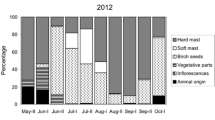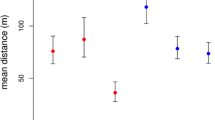Abstract
Yearly variations in the diet composition of the hazel dormouse Muscardinus avellanarius were studied in typical dormouse habitat in Lithuania over 5 years (2010–2014) with different feeding conditions. A high proportion of birch seeds in the dormouse diet in two out of 5 years was a very much unexpected result. Dormice consumed them from mid-June until late October even when the most preferable food—hazel nuts—was abundant. In autumn when accumulating fat reserves for hibernation, hazel dormice fed on four main food sources—fruits of glossy buckthorn, oak acorns, hazel nuts and birch seeds. The consumption of these food sources was directly related to their availability. During the study period, only one, two or three of these food sources were abundant in any particular year, while others were absent or scarce. In total, the fruits of glossy buckthorn and oak acorns accounted for the major portion of dormouse diet in autumn. Dormice living in habitat with irregular fruiting of the main food plants are adapted to feed on varying food sources and can switch from one food source to another in different years.

Similar content being viewed by others
References
Ancillotto L, Sozio G, Mortelliti A (2015) Acorns were good until tannins were found: factors affecting seed-selection in the hazel dormouse (Muscardinus avellanarius). Mamm Biol 80:135–140
Bright PW, Morris PA (1993) Foraging behavior of dormice Muscardinus avellanarius in two contrasting habitats. J Zool 230:69–85
Bright PW, Morris PA (1996) Why are dormice rare? A case study in conservation biology. Mammal Rev 26:157–187
Chanin P, O’Reilly C, Turner P, Kerslake L, Birks J, Woods M (2015) Insects in the diet of the hazel dormouse (Muscardinus avellanarius): a pilot study using DNA barcoding. Mamm Commun 1:1–7
Eden S (2009) Living with dormice. The common dormouse: real rodent or phantom of the ancient wood. Papadakis Publisher, Winterbourne
EUFORGEN (2009) Distribution map of silver birch (Betula pendula). http://www.euforgen.org/distribution-maps/. Accessed 20 Jan 2016
Fietz J, Pflug M, Schlund W, Tataruch F (2005) Influences of the feeding ecology on body mass and possible implications for reproduction in the edible dormouse (Glis glis). J Comp Physiol B 175:45–55
Gil-Delgado JA, Mira Ó, Vińals A, Gómez J, Banyuls N, Vives-Ferrandiz C (2010) Diet of the garden dormouse (Eliomys quercinus Linnaeus 1766) in orange groves: seasonal variation and use of available resources. Mammalia 74:147–151
Grodzinski W, Sawicka-Kapusta K (1970) Energy values of tree-seeds eaten by small mammals. Oikos 21:52–58
Hürner H, Michaux J (2009) Ecology of the edible dormouse (Glis glis) in a western edge population in southern Belgium. Vie Milieu 59:243–250
IUCN (2015) The IUCN Red List of Threatened Species. Version 2015–4. www.iucnredlist.org. Accessed 20 Jan 2016
Juškaitis R (2014) The common dormouse Muscardinus avellanarius: ecology, population structure and dynamics, 2nd edn. Nature Research Centre Publishers, Vilnius
Juškaitis R, Baltrūnaitė L (2013a) Feeding on the edge: the diet of the hazel dormouse Muscardinus avellanarius (Linnaeus 1758) on the northern periphery of its distributional range. Mammalia 77:149–155
Juškaitis R, Baltrūnaitė L (2013b) Seasonal variability in the diet of the forest dormouse, Dryomys nitedula, on the north-western edge of its distributional range. Folia Zool 62:311–318
Juškaitis R, Balčiauskas L, Šiožinytė V (2013) Nest site selection by the hazel dormouse Muscardinus avellanarius: is safety more important than food? Zool Stud 52(53):1–9
Juškaitis R, Baltrūnaitė L, Augutė V (2015) Diet of the fat dormouse (Glis glis) on the northern periphery of its distributional range. Mamm Res 60:155–161
Kuipers L, Scholten J, Thissen JBM, Bekkers L, Geertsma M, Pulles R, Siepel H, van Turnhout L (2012) The diet of the garden dormouse (Eliomys quercinus) in the Netherlands in summer and autumn. Lutra 55:17–27
Lebl K, Kürbisch K, Bieber C, Ruf T (2010) Energy or information? The role of seed availability for reproductive decisions in edible dormice. J Comp Physiol B 180:447–456
Litvaitis JA (2000) Investigating food habits of terrestrial vertebrates. In: Boitani L, Fuller TK (eds) Research techniques in animal ecology: controversies and consequences. Columbia University Press, New York
Magomedov MS, Mamaeva SK, Saypueva EB (2012) Forest dormouse (Dryomys nitedula Pallas 1779) diet characteristic in various forests of foothill zone in Daghestan. South Russ Ecol Dev 2:46–49 (in Russian with English summary)
Morris PA, Morris MJ (2010) A 13-year population study of the edible dormouse Glis glis in Britain. Acta Theriol 55:279–288
Navasaitis M, Ozolinčius R, Smaliukas D, Balevičienė J (2003) Dendroflora of Lithuania. Lututė, Kaunas (in Lithuanian with English summary)
Nowakowski WK, Godlewska M (2006) The importance of animal food for Dryomys nitedula Pallas and Glis glis L. in Białowieża Forest (East Poland): analysis of faeces. Pol J Ecol 54:359–367
Nowakowski WK, Remisiewicz M, Kosowska J (2006) Food preferences of Glis glis (L.), Dryomys nitedula (Pallas) and Graphiurus murinus (Smuts) kept in captivity. Pol J Ecol 54:369–378
Pilastro A, Tavecchia G, Marin G (2003) Long living and reproduction skipping in the fat dormouse. Ecology 84:1784–1792
Ruf T, Fietz J, Schlund W, Bieber C (2006) High survival in poor years: life history tactics adapted to mast seeding in the edible dormouse. Ecology 87:372–381
Sailer M, Fietz J (2009) Seasonal differences in the feeding ecology and behaviour of male edible dormice (Glis glis). Mamm Biol 74:114–124
SFSS (State Forest Survey Service) (2015) Lithuanian statistical yearbook of forestry. http://www.amvmt.lt/index.php/leidiniai/misku-ukio-statistika/2015. Accessed 20 Jan 2016 (in Lithuanian and English)
StatSoft, Inc. (2004) Statistica (data analysis software system), version 7. www.statsoft.com
Vekhnik VA (2011) Reproductive strategy of the edible dormouse (Glis glis L. 1766) at the periphery of the range. Summary of dissertation for the degree of Candidate of Biological Science. Tolyatti (in Russian)
Acknowledgments
This research was funded by the European Social Fund under the Global Grant measure (grant no. VP1-3.1-ŠMM-07-K-01-026). J. A. Gil-Delgado, M. Niedziałkowska, V. Augutė and anonymous reviewers made useful comments which improved the manuscript. J. Stratford revised the English language, and G. Vaitonis helped in the preparation of figure.
Author information
Authors and Affiliations
Corresponding author
Additional information
Communicated by: Magdalena Niedziałkowska
Electronic supplementary material
ESM 1
(PDF 23 kb)
Rights and permissions
About this article
Cite this article
Juškaitis, R., Baltrūnaitė, L. & Kitrytė, N. Feeding in an unpredictable environment: yearly variations in the diet of the hazel dormouse Muscardinus avellanarius . Mamm Res 61, 367–372 (2016). https://doi.org/10.1007/s13364-016-0280-2
Received:
Accepted:
Published:
Issue Date:
DOI: https://doi.org/10.1007/s13364-016-0280-2




